
Bostogné, Boston or Boston Whist is an 18th-century trick-taking card game played throughout the Western world apart from Britain, forming an evolutionary link between Hombre and Solo Whist. Apparently named after a key location in the American War of Independence, it is probably a French game which was devised in France in the 1770s, combining the 52-card pack and logical ranking system of partnership Whist with a range of solo and alliance bids borrowed from Quadrille. Other lines of descent and hybridization produced the games of Twenty-five, Préférence and Skat. Its most common form is known as Boston de Fontainebleau or French Boston.
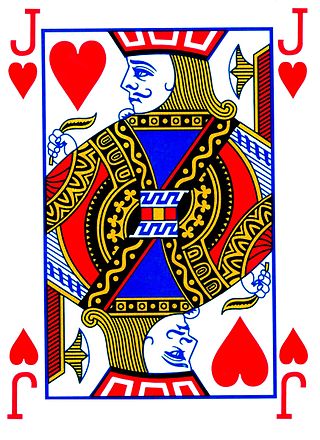
Reversis, or more rarely, Réversi, is a very old trick-taking card game in the Hearts family. Its origin is uncertain, but it may have emerged in Italy before spreading to Spain and France. It is considered one of the two probable ancestors of Hearts, Black Lady and Black Maria, the other being Coquimbert or Coquinbert. It was very popular with the French aristocracy in the 17th and 18th centuries, and much played elsewhere, except in Britain. Initially quite simple, the game eventually developed more complex mechanics such as vast quantities of counters and a system of pools and side-payments. Its name may have possibly come from the reverse order and construction of the game itself, or even from its exceptional slam which, like "shooting the moon" in Black Lady, reverses the entire aim of the game.

Gilet, also Gile, Gillet, is a 16th-century Italian gambling card game that probably predates the game of Primero. Rabelais, in 1534, gives it pride of place in his list of games played by Gargantua, and Cardano, in 1564, describes it as Geleus, from the word Geleo, meaning "I have it".
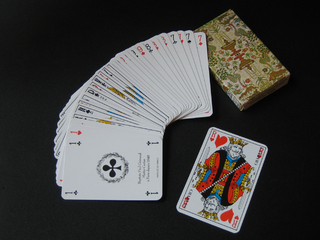
Brusquembille or Briscambille is an historical, French, 3-card trick-and-draw game for two to five players using a 32-card piquet pack. The game has variable trumps. Side-payments are made for keeping or winning aces and tens.

Bestia is an Italian card game. It is a gambling game and is similar to Briscola and Tressette. The word bestia means beast.
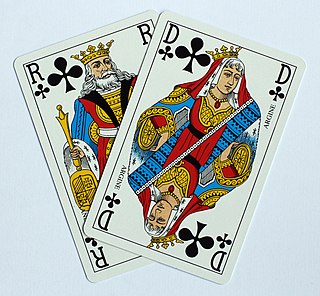
Briscan is an 18th-century, French Ace-Ten card game for two players played with a 32-card Piquet pack. It is a member of the Marriage group of games in which the 'marriage' of a King and Queen brings a bonus score, but Briscan takes this simple concept to extraordinary lengths.

Mouche, also known as Lanterlu, is an old, French, trick-taking card game for two to six players which has elements, such as bluffing, reminiscent of the much later game of poker. It is a member of the Rams family of games and, although it is a gambling game, often played for small stakes, it is also suitable as a party game or as a family game with children from the age of 12 upwards. It is named after the mouche, a term that variously refers to its winning hand, the basic stake and the penalty for failing to take any tricks. Although also called Bête, it should not be confused with the older game of that name from which it came and which, in turn, was a derivative of Triomphe.
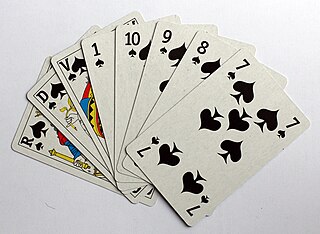
Bête, la Bête, Beste or la Beste, originally known as Homme or l'Homme, was an old, French, trick-taking card game, usually for three to five players. It was a derivative of Triomphe created by introducing the concept of bidding. Its earlier name gives away its descent from the 16th-century Spanish game of Ombre. It is the "earliest recorded multi-player version of Triomphe".

The game of Nain Jaune or Yellow Dwarf, also formerly called Lindor, is an "attractive and unique traditional French card game" using a board comprising five compartments or boxes. It is a reasoned game of chance because it combines the hazards of card distribution with the strategy of building suits. Nain Jaune, which is considered a classic French game, is named after the seven of diamonds, which is depicted as a yellow dwarf in the centre of the game board.

Coucou ("Cuckoo") is an historical French card game that uses a pack of 32 or 52 cards and is played by five to twenty players. It is unusual for being played with only a single card in hand. As a shedding game, there is only one winner who may claim the stakes, if there are any. The game has also been called As Qui Court or Hère.

Homme d'Auvergne is an historical French card game for two to five players dating to the 17th century. It is a derivative of Triomphe and ancestral to la Bête with which it gradually become almost identical over time. It was a source of inspiration for other games, such as Écarté.

Culbas or Cul-bas is an historical French card game of the fishing type for three to eight players that dates to at least the 17th century. It is described as being "very old" and having "a great simplicity in which chance plays the biggest role."
Comet is a very old, French card game of the Stops family for 2 to 5 players that is still played today. It was originally called Manille, but acquired a new name on the appearance of Halley's Comet in 1682. It is not related to the modern trick-taking game also called Manille. The American game of Commit is an evolution of Comet.

Hoc Mazarin, also just Hoc, is an historical French gambling game of the Stops family for two or three players. The game was popular at the court of Versailles in the 17th century and was named after Cardinal Mazarin, chief minister to the King of France.

Emprunt is an historical French card game of the Hoc family for three to six players that dates to at least the early 18th century.
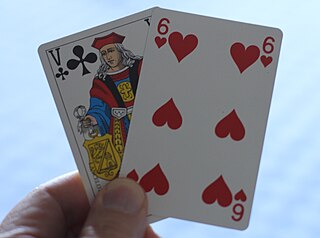
Ferme ("Farm") is an historical French gambling game of the banking type for ten to twelve players that dates to the mid-17th century. It was described then as being "fun and recreational".
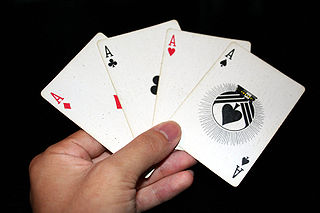
Romestecq is an historical Dutch card game for two, four or six players in two teams that dates to at least the 17th century. It was also popular in France for over a century. Despite being criticised in contemporary sources as "complicated" it continued to appear in the literature until the end of the 19th century and was sufficiently interesting for it to appear in The Penguin Book of Card Games in 2008.

Papillon is an old French card game of the fishing type for three or four players. It has been described as "perfect for children who know how to count".

Sizette is an historical French card game for six players in two teams of three. It is unusual in that communication between partners is allowed and the team captain is permitted to ask for information and direct play. It has been described as one of the most enjoyable games of cards, albeit one requiring skill to play well. It is a form of Whist for six players.

Quadrette is an old French card game for four players, who form two teams of two. It is unusual in that communication between partners is allowed and the team captain is permitted to ask for information and direct play. It is a variant of classic Whist that is simpler and faster to play.















